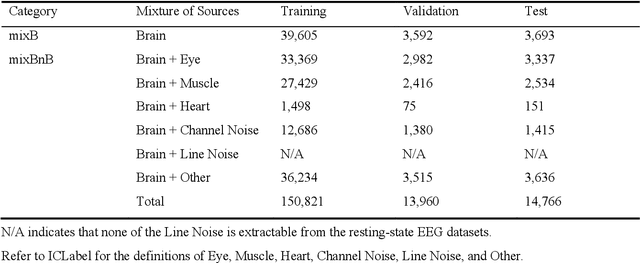Chih-Sheng Huang
ART: Artifact Removal Transformer for Reconstructing Noise-Free Multichannel Electroencephalographic Signals
Sep 11, 2024Abstract:Artifact removal in electroencephalography (EEG) is a longstanding challenge that significantly impacts neuroscientific analysis and brain-computer interface (BCI) performance. Tackling this problem demands advanced algorithms, extensive noisy-clean training data, and thorough evaluation strategies. This study presents the Artifact Removal Transformer (ART), an innovative EEG denoising model employing transformer architecture to adeptly capture the transient millisecond-scale dynamics characteristic of EEG signals. Our approach offers a holistic, end-to-end denoising solution for diverse artifact types in multichannel EEG data. We enhanced the generation of noisy-clean EEG data pairs using an independent component analysis, thus fortifying the training scenarios critical for effective supervised learning. We performed comprehensive validations using a wide range of open datasets from various BCI applications, employing metrics like mean squared error and signal-to-noise ratio, as well as sophisticated techniques such as source localization and EEG component classification. Our evaluations confirm that ART surpasses other deep-learning-based artifact removal methods, setting a new benchmark in EEG signal processing. This advancement not only boosts the accuracy and reliability of artifact removal but also promises to catalyze further innovations in the field, facilitating the study of brain dynamics in naturalistic environments.
IC-U-Net: A U-Net-based Denoising Autoencoder Using Mixtures of Independent Components for Automatic EEG Artifact Removal
Nov 22, 2021



Abstract:Electroencephalography (EEG) signals are often contaminated with artifacts. It is imperative to develop a practical and reliable artifact removal method to prevent misinterpretations of neural signals and underperformance of brain-computer interfaces. This study developed a new artifact removal method, IC-U-Net, which is based on the U-Net architecture for removing pervasive EEG artifacts and reconstructing brain sources. The IC-U-Net was trained using mixtures of brain and non-brain sources decomposed by independent component analysis and employed an ensemble of loss functions to model complex signal fluctuations in EEG recordings. The effectiveness of the proposed method in recovering brain sources and removing various artifacts (e.g., eye blinks/movements, muscle activities, and line/channel noises) was demonstrated in a simulation study and three real-world EEG datasets collected at rest and while driving and walking. IC-U-Net is user-friendly and publicly available, does not require parameter tuning or artifact type designations, and has no limitations on channel numbers. Given the increasing need to image natural brain dynamics in a mobile setting, IC-U-Net offers a promising end-to-end solution for automatically removing artifacts from EEG recordings.
MS-DARTS: Mean-Shift Based Differentiable Architecture Search
Sep 01, 2021



Abstract:Differentiable Architecture Search (DARTS) is an effective continuous relaxation-based network architecture search (NAS) method with low search cost. It has attracted significant attentions in Auto-ML research and becomes one of the most useful paradigms in NAS. Although DARTS can produce superior efficiency over traditional NAS approaches with better control of complex parameters, oftentimes it suffers from stabilization issues in producing deteriorating architectures when discretizing the continuous architecture. We observed considerable loss of validity causing dramatic decline in performance at this final discretization step of DARTS. To address this issue, we propose a Mean-Shift based DARTS (MS-DARTS) to improve stability based on sampling and perturbation. Our approach can improve bot the stability and accuracy of DARTS, by smoothing the loss landscape and sampling architecture parameters within a suitable bandwidth. We investigate the convergence of our mean-shift approach, together with the effects of bandwidth selection that affects stability and accuracy. Evaluations performed on CIFAR-10, CIFAR-100, and ImageNet show that MS-DARTS archives higher performance over other state-of-the-art NAS methods with reduced search cost.
 Add to Chrome
Add to Chrome Add to Firefox
Add to Firefox Add to Edge
Add to Edge